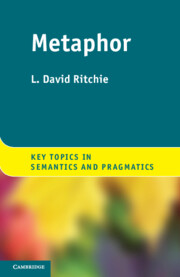Book contents
- Frontmatter
- Contents
- Figures
- Acknowledgments
- 1 Introduction
- 2 Understanding metaphors
- 3 Categorization and relevance
- 4 Conceptual metaphors
- 5 Perceptual simulation
- 6 Metaphors and framing effects
- 7 Language play
- 8 Metaphors in conversation
- 9 Metaphors in politics
- 10 Metaphors in literature
- 11 Closing reflections
- Glossary
- Bibliography
- Index
4 - Conceptual metaphors
Published online by Cambridge University Press: 05 February 2013
- Frontmatter
- Contents
- Figures
- Acknowledgments
- 1 Introduction
- 2 Understanding metaphors
- 3 Categorization and relevance
- 4 Conceptual metaphors
- 5 Perceptual simulation
- 6 Metaphors and framing effects
- 7 Language play
- 8 Metaphors in conversation
- 9 Metaphors in politics
- 10 Metaphors in literature
- 11 Closing reflections
- Glossary
- Bibliography
- Index
Summary
While he was in school he fell in love, but the relationship didn’t go anywhere and it quickly cooled off – it was a complete dead-end.
In 1980 George Lakoff and Mark Johnson proposed an approach to metaphor radically different from those described in Chapters 2 and 3. Lakoff and Johnson argue that metaphorical expressions in language express underlying conceptual metaphors, in which the metaphor topic is experienced as the vehicle. “Our ordinary conceptual system, in terms of which we both think and act, is fundamentally metaphorical in nature” (Lakoff and Johnson, 1980, p. 3). According to Lakoff and Johnson, ‘fell in love’ expresses the conceptual metaphors love is a container and control is up / loss of control is down. “The essence of metaphor is understanding and experiencing one kind of thing in terms of another” (Lakoff and Johnson, 1980, p. 5).
When we use these metaphors we experience love as a container that encloses the lover. We experience the onset of love, in which lovers are no longer in control of their emotions, as falling through physical space. When we speak or hear of a relationship that ‘didn’t go anywhere’ and was ‘a dead-end,’ we understand the relationship in terms of the conceptual metaphor love is a journey, and experience the failure as a cessation of motion through physical space that is caused by being ‘on a street that is blocked.’ I will begin this chapter with a summary of conceptual metaphor theory, and then discuss several examples of conceptual metaphors.
Information
- Type
- Chapter
- Information
- Metaphor , pp. 68 - 87Publisher: Cambridge University PressPrint publication year: 2013
